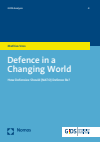Zusammenfassung
Was bedeutet „Verteidigung“, wo fängt sie an und wo endet sie? Der Autor zeigt eine Vielzahl wichtiger Facetten auf, stellt neue Methoden für die Diskussion zur Verfügung und kommt zu konkreten Ableitungen, um sich dem Begriff zu nähern. Da die Frage nicht nur aus akademischer Sicht interessant, sondern auch zentral für die aktuelle Diskussion zur Ausrichtung der NATO ist, wendet sich das Buch an Forschende und Praktiker gleichermaßen.
Der Autor beleuchtet den nebulösen Begriff und dahinterstehende Konzepte aus ganz unterschiedlichen Blickwinkeln – historisch, politisch, rechtlich und militärisch – und entwickelt daraus das Modell der „Strategical Analysis“, das zentrale Fragestellungen sicht- und greifbar macht. Eine große Rolle spielt in der Betrachtung das Verteidigungsverständnis der NATO von der Gründung über die drei Phasen ihrer Geschichte bis in die heutige Zeit. Im ständigen Wandel der globalen Rahmenbedingungen werden immer neue Anforderungen an die Verteidigung der Allianz gestellt. Von den grundsätzlichen Überlegungen zur Verteidigung leitet der Autor konkrete Empfehlungen für den laufenden Anpassungsprozess der NATO ab.
Abstract
The author takes the reader on a swift and sweeping ride through different aspects of defence. What is the core of defence in general? And what is defence today for the most prominent of all defensive alliances, for NATO, which is in the midst of a reflection process on what its role in the future should be?
The notoriously vague and shadowy term “defence” is illuminated from different angles, culminating in the newly introduced model of “strategical analysis”. The historical perspective comprises examples varying from China’s Great Wall to the Israeli-Arab Six Days War and NATO’s history with a specific focus on its understanding of defence from its foundation, through all three ages of its existence and into today’s still and again changing world. More insights are drawn from the application of the prevalent judicial, political and military strategic approaches and terms.
From this kaleidoscopic view, the author draws practical conclusions and formulates clear and pointed recommendations for the persistent and particularly in NATO very current discussion about how the understanding of defence should – or should not – evolve.
- 71–82 4 Defence Today 71–82
- 83–100 5 Conclusion 83–100
- 101–109 6 Bibliography 101–109

